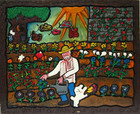Carl Dixon
Carl Dixon holds a special place in the Sacred Art Pilgrim Collection as a creator of sculpted, wood panel paintings. These bas-relief pictures come out of a school of African-American wood carving rooted in traditional West African folk art, whose most notable modern practitioner was Elijah Pierce (1892-1984), a barber-preacher-turned-woodworker in Columbus, Ohio. Like Pierce, Dixon is a committed Christian, his faith deepened by a bout with cancer. He sees his sacred art pieces in wood as a way “to share my feelings about what I read in the Bible with others.” Before he begins working on a biblical subject, he studies the scriptural texts and spends time in prayer. “I give God all the credit,” he says. “God loads us up with all the equipment we’re going to need.”
The Mississippi-born Dixon is a self-taught artist. A teacher spotted Dixon’s talent, when he was the first black student to take an art course in his newly integrated high school. Carl received vocational training as a brick mason but returned to art-making, when a childhood friend persuaded him to try wood carving on a router machine. The two aspiring artisans began making decorative address signs but soon moved on to bas-relief portraits of Michael Jackson, Prinz, and other black pop cultural icons for neighborhood kids. (Carl made an image in this style of my father, Andy the Prayer Warrior.) Dixon was inspired to create carved wood paintings on biblical themes by a Sunday School teacher who used cardboard cut-outs as visual aides.
Dixon begins each piece by blocking out his subject on a plywood panels (mostly made from birch), using a T-square, “just like I was drawing a house plan.” Then, he carves out the areas he wants in relief with a router machine or the occasional hand tool, painting in the details of his pictures with water-based colors and acrylics. He finishes things off with a touch of glitter and a coat of lacquer. Dixon likes to turn the outer edges of his panels into decorative frames with Bible references. For all his attention to craft, Carl is highly intuitive in his approach to art-making and can be counted among a group of "visionary" artists of the American South, which includes Howard Finster and Rudolph Valentino Bostic.
A beautiful example of this type of inspired art is Dixon's self-portrait, titled Thanks in Jesus With Love. Underneath a figure of Jesus, lying in the tomb, awaiting resurrection, sleeps the artist in a baseball cap, cocooned in a maroon blanket. Surrounding him are dream-visions of favorite Bible stories, recounting deeds of heroism, healing and love. Starting from the top right, moving clockwise, you can see Jesus and the woman at the well, Moses parting the Red Sea, the three Hebrews in the fiery furnace, Moses and the burning bush, the raising of Lazarus, Jesus and the woman taken in adultery, Jesus walking on water, the entombment and Resurrection of Jesus.
In Praying and Preaching Door, Dixon has created a sermon in wood out of an old door, using its five panels to present stories about great prophets, apostles, preachers and people of prayer from the Old and New Testaments in the style of a medieval altarpiece. His central image of Christ, praying his great pastoral prayer, recorded in John 17:1-26, is framed on the left by a picture of Paul and Silas, praying in prison (Acts 16:25), and the Prophets Elijah and Elisha, awaiting the Fiery Chariot (2 Kings 2:11-22). On the right, you can see Peter and John, healing the lame man (Acts 3:1-26), and Moses and Aaron, leaving for Egypt (Exodus 4:27-31). A heavy piece, both in content and weight!
Carl Dixon has taken on over forty commissions--and still counting--since his work first entered the Sacred Art Pilgrim Collection in 2009. One theme posed a special challenge for him--a single wood panel painting bringing together all fourteen Stations of the Cross from the traditional Good Friday devotional service with a final image of the Resurrection. The conventions of this genre of sacred art require the artist to present separate images of the events on Christ's journey along the Way of Sorrow to Golgotha with repeated visual motifs to connect the scenes, as we see in the positioning of the Cross and Christ's striking red and blue garments in eight of the panels. The Passion of Christ narrative follows a zig-zag line from Christ's condemnation by PIlate at the upper left to his rising from the tomb at the lower right.
Dixon may be serious about his theological themes, but he often adds a few whimsical touches. In Spiritual Warfare & the Fruits of the Spirit, bands of angels struggle with the forces of darkness in the heavenly realms, while a revival meeting takes place on earth. On the lower right, a guardian angel keeps his youthful charge from slipping out of church, while cupid-like angels in the upper left shoot darts of love into the demonic ranks. Among the crowds streaming to the manger in his Christmas carol-inspired piece, O Come All Ye Faithful, you will not only find figures from the Bible like the Shepherds, the Woman at the Well and Zacchaeus but also President Barak Obama and his family, Civil Rights Leader Martin Luther King, Jr., and Entertainers Michael Jackson and Whitney Houston!
It's still too early in Dixon's career to talk about "masterworks," but he has, certainly, attempted something akin to a Sistine Chapel ceiling in wood in his Life of Christ panel. In 23 vignettes of varying shapes and sizes, Dixon recounts the story of Jesus' life from the Annunciation to his Ascension into Heaven. All the the expected events can be found in this marvelous mosaic of images: Christ's Nativity, Baptism, Transfiguration, Crucifixion and Resurrection, plus some unexpected additions like the miracle of the miraculous catch of fish, the Parable of the Mustard Seed, and a delightful scene of the Boy Jesus, working in Joseph's carpentry shop. Says Carl: “When you get into the Bible, it will take you to places you just wouldn't believe!
Dixon's skill in handling multi-figured, large format paintings on biblical and historical themes can be seen in another piece in the collection, Exodus: Journeys of Liberation. At the center of the painting, Christ exits the tomb in the ultimate journey of liberation, when he overcame death to bring us eternal life. On the left side of the picture, Moses leads the Children of Israel through the Red Sea, which has miraculously parted to allow their escape from Egypt. In a parallel image, Harriet Tubman, nicknamed “Moses,” leads African-Americans out of slavery on the Underground Railroad. In the background, Barak Obama, Rosa Parks, and Martin Luther King Jr. remind us of other milestone moments on the African-American road to Freedom.
Themes of social justice are close to the artist's heart. In Acts of Mercy, he illustrates the six good deeds in the Last Judgment narrative found in Matthew 25:31-46 that we offer to Christ when we help to others in need, including a visual vignette of Martin Luther King Jr. behind bars, drafting a call for civil rights in his famous "Letter from the Birmingham Jail." After an act of police brutality led to the death of the African-American, George Floyd, in May 2020, Dixon painted the wood panel piece,"I Can't Breathe," reinterpreting Floyd's last words in three different ways. Beside a scene of his death, we see Black Lives Matter demonstrators choking from clouds of tear gas, while doctors struggle to keep a COVID-19 sufferer alive with a ventilator. Angels with face masks hover above the central image of the Crucifixion, reminding us how Christ, too, struggled to breathe while dying on the Cross to save humanity.
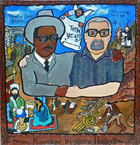
Kingdom Treasure Hunters
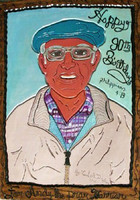
Andy the Prayer Warrior
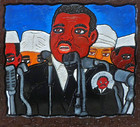
"I Have a Dream"
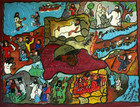
Thanks in Jesus With Love

Praying and Preaching Door
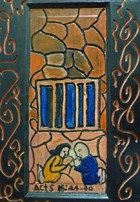
Praying and Preaching Door (detail)
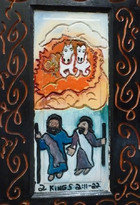
Praying and Preaching Door (detail)
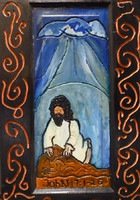
Praying and Preaching Door (detail)
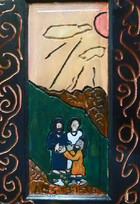
Praying and Preaching Door (detail)
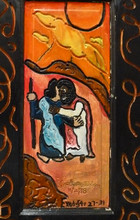
Praying and Preaching Door (detail)
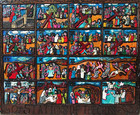
The Stations of the Cross

The Life of Christ
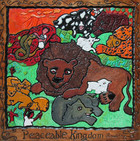
Peaceable Kingdom
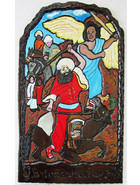
Balaam’s Donkey
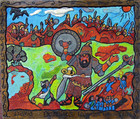
David Defeats Goliath
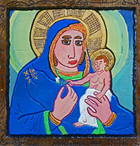
Madonna and Child (After Giotto)

O Come All Ye Faithful
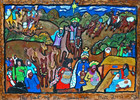
The Visit of the Wise Men

The Flight into Egypt
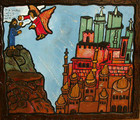
The Enemy of God Tempts Jesus

The Woman at the Well

Jesus Christ Feeds 5,000

The Good Samaritan
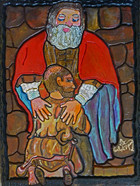
The Return of the Prodigal Son (After Rembrandt)

Prodigal Son: The Departure

Prodigal Son: the Return
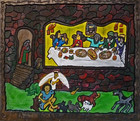
The Parable of the Rich Man & Lazarus

The Parable of the Sower
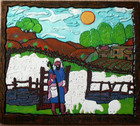
The Good Shepherd
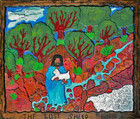
The Lost Sheep
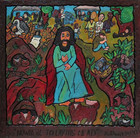
"Nowhere to Lay His Head"

Jesus Preaching in the Temple

Jesus Cleansing the Temple
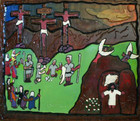
Good Friday & Easter Sunday
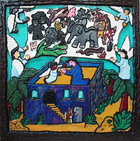
"Do Not Call Anything Unclean"
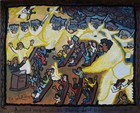
Spiritual Warfare & the Fruits of the Spirit

Take Up Your Cross

The Walk of Faith

Exodus: Journeys of Liberation
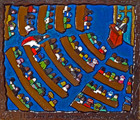
The Voice of One Crying in the Wilderness
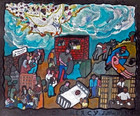
Acts of Mercy

The Gadarene Swine

"I Can’t Breathe"
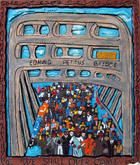
"We Shall Overcome"
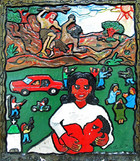
Thou Shalt Not Kill
